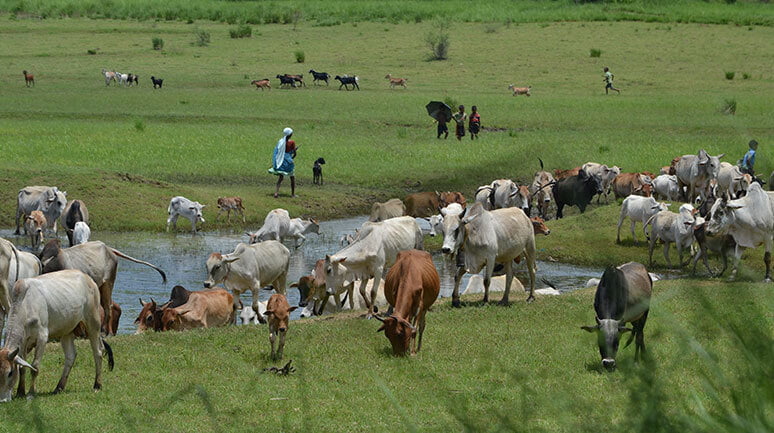
Traditional gauchar land maintenance practices can play an important role in mitigating and adapting to climate change. Gauchar lands are communal lands where livestock can graze freely, and they have been an integral part of traditional agriculture and rural livelihoods in India for centuries. These lands are typically managed by local communities using traditional knowledge and practices, such as rotational grazing, agroforestry, and controlled burning.
Such traditional practices can help maintain soil health and increase carbon sequestration, thereby mitigating climate change. For example, rotational grazing can promote the growth of perennial grasses and increase soil organic matter, leading to carbon storage in the soil. Similarly, agroforestry, which involves integrating trees and shrubs into agricultural landscapes, can help sequester carbon in the biomass and soil while also providing additional benefits such as improved soil fertility, biodiversity conservation, and resilience to climate variability.
In addition to mitigating climate change, traditional gauchar land management practices can also help communities adapt to the impacts of climate change. For example, the maintenance of vegetative cover on gauchar lands can help prevent soil erosion and reduce the risk of landslides, which can become more frequent and severe in a changing climate. Furthermore, traditional knowledge and practices related to water harvesting and management can help communities cope with water scarcity and drought, which are expected to become more prevalent in many parts of India due to climate change.
However, in recent years, the traditional management of gauchar lands has been eroding due to various factors such as changing land use patterns, urbanization, and the decline of traditional livelihoods. This has led to a loss of ecosystem services, including carbon sequestration and adaptation benefits, and has contributed to the degradation of the lands themselves. Therefore, it is important to support the revival and promotion of traditional gauchar land management practices as part of broader efforts to address climate change and promote sustainable development.
Here are some points explaining how gauchar land survival is necessary for climate resilience:
- Carbon sequestration: Gauchar lands can play an important role in carbon sequestration, which is essential for mitigating climate change. These lands can help store carbon in the soil and biomass through practices such as agroforestry and rotational grazing.
- Biodiversity conservation: Gauchar lands are often rich in biodiversity, providing habitat for a variety of plant and animal species. The conservation of such lands can help maintain biodiversity and ecosystem services, which are essential for climate resilience.
- Water management: Traditional gauchar land management practices often involve water harvesting and management, which can help communities cope with water scarcity and drought, both of which are expected to become more prevalent in many parts of India due to climate change.
- Soil conservation: Gauchar lands can help maintain soil health and prevent erosion, which is essential for sustaining agricultural productivity and ecosystem services.
- Livelihoods and food security: Gauchar lands are often used for livestock rearing and traditional agriculture, which can provide important sources of livelihoods and food security for rural communities. The conservation of these lands can help maintain these traditional livelihoods, which are often well adapted to local environmental conditions and can contribute to climate resilience.
- Adaptation to climate variability: Traditional gauchar land management practices, such as agroforestry and rotational grazing, can increase resilience to climate variability by promoting ecosystem services such as soil fertility, water availability, and biodiversity conservation.
The study published in the journal Land Use Policy in 2019 aimed to assess the current status and potential of gauchar lands in India for sustainable land management and climate change mitigation and adaptation. Gauchar lands are communal lands where livestock can graze freely, and they have been an integral part of traditional agriculture and rural livelihoods in India for centuries.
The study found that gauchar lands cover approximately 17% of the total geographical area of India, which is a significant land resource. These lands provide a range of ecosystem services, including carbon sequestration, biodiversity conservation, soil conservation, and water management. For example, gauchar lands can store carbon in the soil and biomass through practices such as agroforestry and rotational grazing. They can also help maintain soil health and prevent erosion, which is essential for sustaining agricultural productivity and ecosystem services. Moreover, gauchar lands are often rich in biodiversity, providing habitat for a variety of plant and animal species.
However, the study also highlighted the increasing pressures on gauchar lands from various factors such as urbanization and changes in land use patterns. This has led to a loss of ecosystem services, including carbon sequestration and adaptation benefits, and has contributed to the degradation of the lands themselves. Therefore, the study recommended the need to promote sustainable management practices for gauchar lands, such as rotational grazing, agroforestry, and controlled burning, to maintain their ecosystem services and contribute to climate resilience.
In summary, the survival of gauchar lands is necessary for climate resilience, as they can contribute to carbon sequestration, biodiversity conservation, water and soil management, traditional livelihoods and food security, and adaptation to climate variability. Therefore, it is important to support the conservation and promotion of traditional gauchar land management practices as part of broader efforts to address climate change and promote sustainable development.
